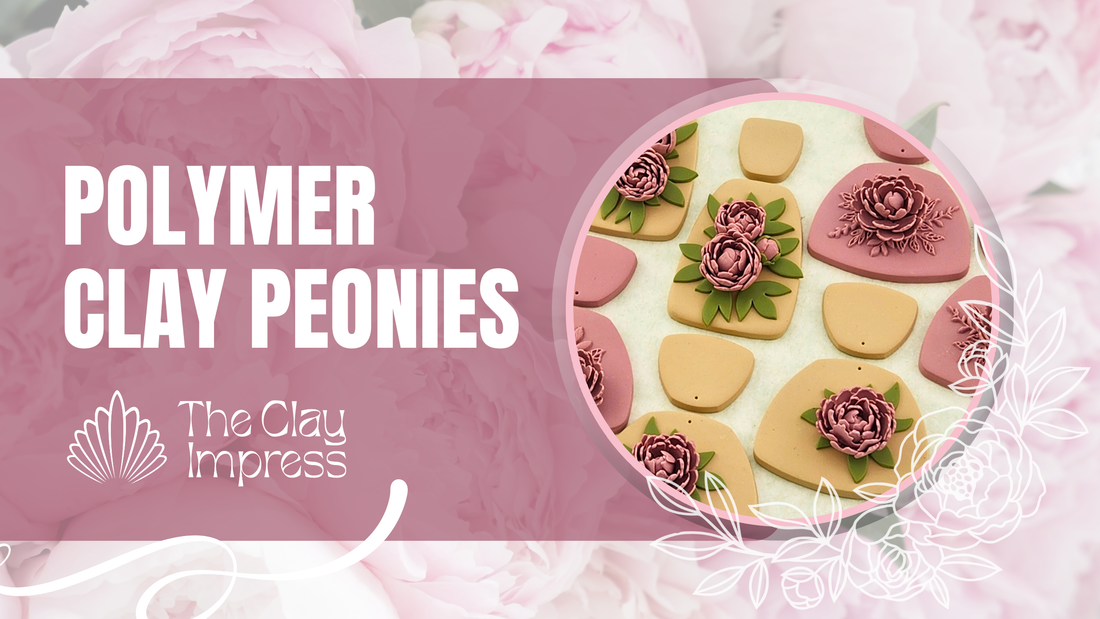
How to Make Polymer Clay Peonies | Step-by-Step Tutorial with Video
Peonies are full, delicate flowers with layers of soft petals. In this tutorial, I’ll show you how to use the 3D Peony Cutter Set to make beautifully dimensional blooms perfect for earrings, pendants, or floral arrangements. These peonies finish at about 1.2 cm in size, so they’re detailed but still manageable to work with.
Tools & Materials
For this tutorial, I used:
- 3D Peony Cutter Set (petals + leaves)
- Well-conditioned polymer clay (not too sticky or too dry; leach fresh clay if needed)
- Ball tools (for thinning and cupping petals)
- Silicone/dotting tool (to pick up and place petals)
- Tissue blade
- Acrylic cutter press
- Cornstarch (to keep tools from sticking)
- Foam pad (essential for shaping petals)
- Kato Poly Paste or Sculpey Oven-Bake Adhesive (optional adhesive)
Step 1. Preparing the Clay
Roll out your clay into a very thin slab using a pasta machine or thickness guides. The slab should be approximately 0.7 mm thick. I recommend the #8 setting on the Atlas (second thinnest). Thin clay helps petals keep their shape when cupped and prevents your peonies from looking too thick or heavy.
Step 2. Cutting the Petals
- Dip your cutter into cornstarch and tap off the excess.
- Cut the clay four to five times with the petal cutter. That is usually enough for one full peony.
- Use a tissue blade to lift the petals from your surface. Instead of scraping the entire petal and stem off the cutting surface, slide the blade under just the stems and gently pat the stems to secure them to the tissue blade before peeling the rest of the petals off the cutting surface. The petals will stay on the tissue blade through the next step, as it makes them easier to work with.
Step 3. Shaping the Petals
On your foam pad, with the stems of the petals still attached to the tissue blade, use ball tools to thin and cup each petal:
- Tip: use the smallest ball tool for the two smallest petals, which form the innermost layer of the peony. Use the second smallest ball tool for the larger petals.
Work in gentle circles or arches, thinning the edges and forming a shallow cup. Do not worry if petals end up looking slightly different. Natural variation makes the flower more realistic.
Step 4. Making the Base Cone
Form a small cone of clay. It does not need to be perfect. This is just the base that your petals will wrap around. The tip will usually be hidden by the first petals.
Step 5. Building the Peony
Attach petals from smallest to largest, slightly overlapping each layer:
- Start with the smallest petals. Place the first on the cone and bend it inward to cover the tip. Work around the peony, placing small petals until you come back around to where you started.
- Move to the next largest petals, the mitten-shaped ones, and place them around the cone in the same fashion, overlapping slightly as you go.
- Add the next fan-shaped petals, overlapping again for fullness.
- Finish with the largest heart-shaped petals around the outside.
Step 6. Adjusting the Shape
- For a full, open peony, let the petals spread naturally as you build.
- For a tighter bud-like peony, after each petal, gently press it inward toward the center to keep the bloom closed.
- You can stop partway through the layers for a half-open look.
Step 7. Removing the Flower
Use the side of your dotting tool to press and roll the area below the petals firmly together, and to form a small neck below the flower. You want to create a neck so the flower does not have a large flat spot on the bottom when you cut it off. Be mindful to ensure all of the petals above the neck are thoroughly attached, otherwise when you cut the flower off the cone, they may fall off.
Once the bloom is complete and the neck under the flower has been reduced:
- Use a tissue blade to carefully slice it off the cone.
- Do not cut too far into the petals. Only remove excess clay at the base.
- Smooth the underside if needed.
Step 8. Adding Leaves
Cut leaves using the included leaf cutter. Arrange 2–4 leaves in a small cluster or circle, then add your peony in the center. You can also cup the leaves slightly with a ball tool for added dimension.
Step 9. Creating Variations
One of the best parts of this set is how much range you can get from a single group of cutters. If you use every petal size and allow the outer layers to open, you will get a large, fluffy bloom that reads as a statement focal. If you stop after two or three layers and keep pressing each new petal slightly inward, you will get a smaller bloom that tucks nicely into arrangements.
For buds, fold two small pink petals over the top of a cone to suggest the inner petals, then wrap with a few green petals so the form feels tight and fresh. Mixing a full peony with a tighter bloom and a small bud immediately creates a more natural, garden-like composition, especially when you vary the tilt and spacing of each flower.
Step 10. Designing Earrings
Your finished peonies can be styled in many ways. Try pairing them with:
- Leaf clusters for a natural botanical look
- Textured backdrops like the Bloom Base Botanical Bouquet Texture Sheet
- Monotone designs where the flower and backdrop are the same color
When attaching delicate flowers to a slab, use a dab of poly paste so you do not need to press them down too firmly.
Final Bake
Bake according to your clay’s instructions. I recommend at least 1 hour at the manufacturer’s temperature to ensure full curing. Once baked, your peonies will hold their delicate form beautifully.
Video Tutorial
Prefer to watch the process step by step? Play the full tutorial below:
